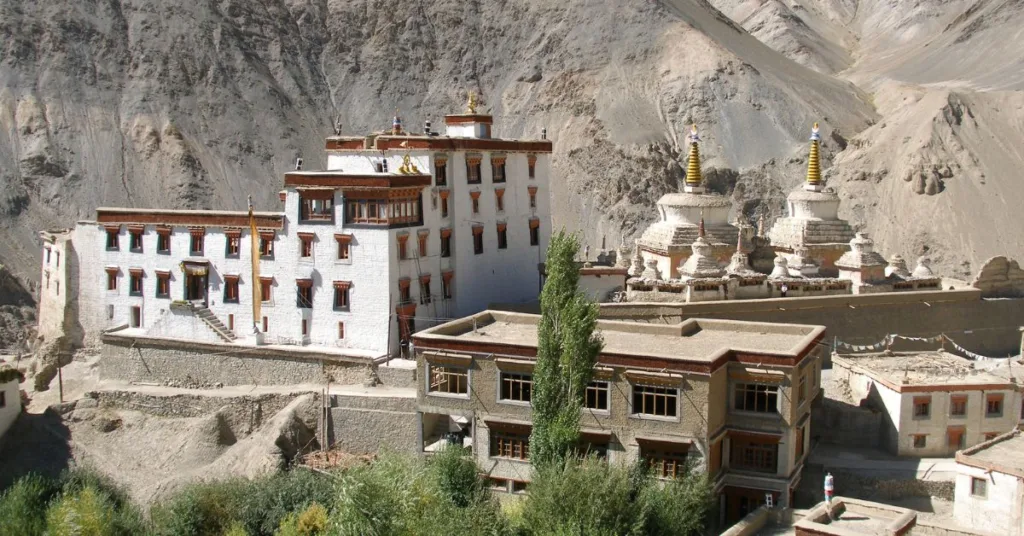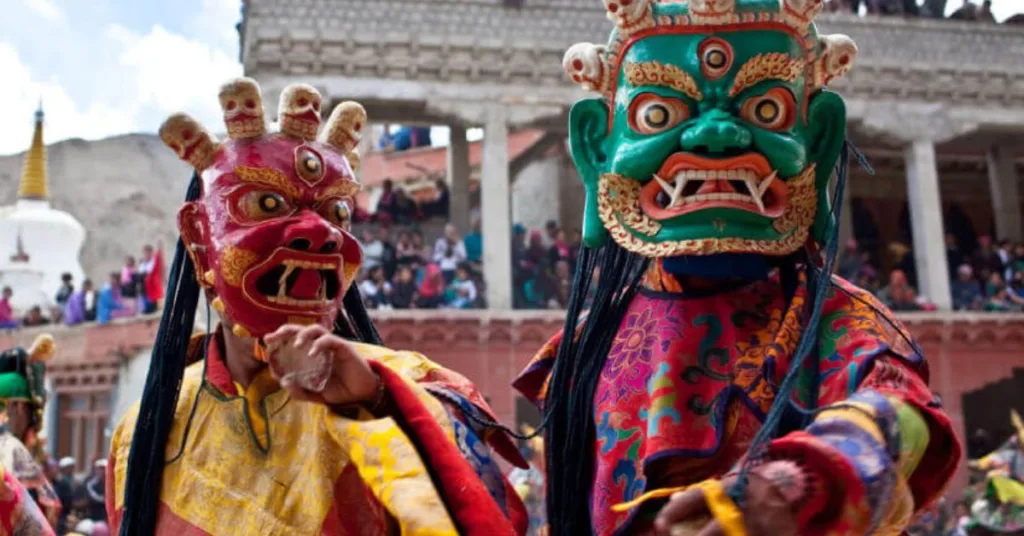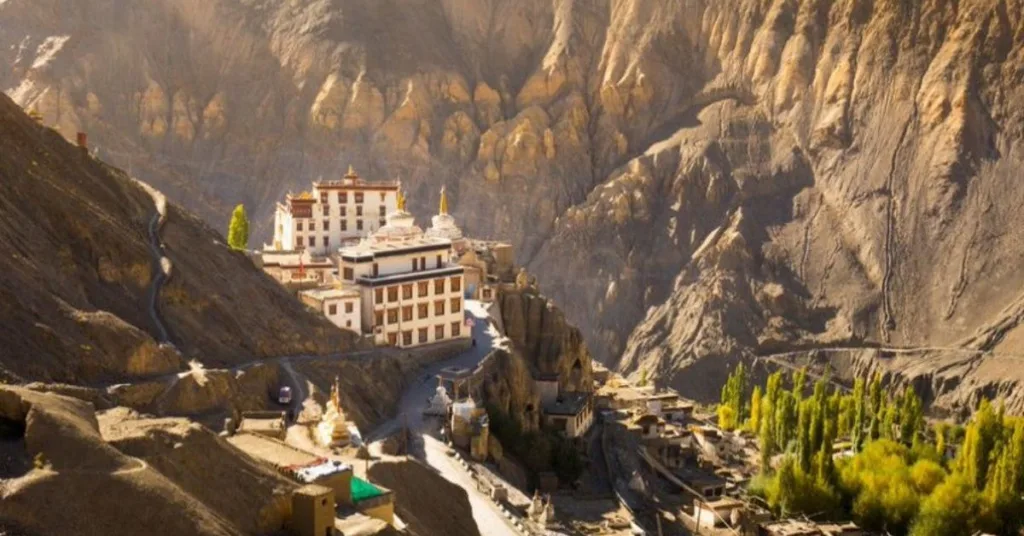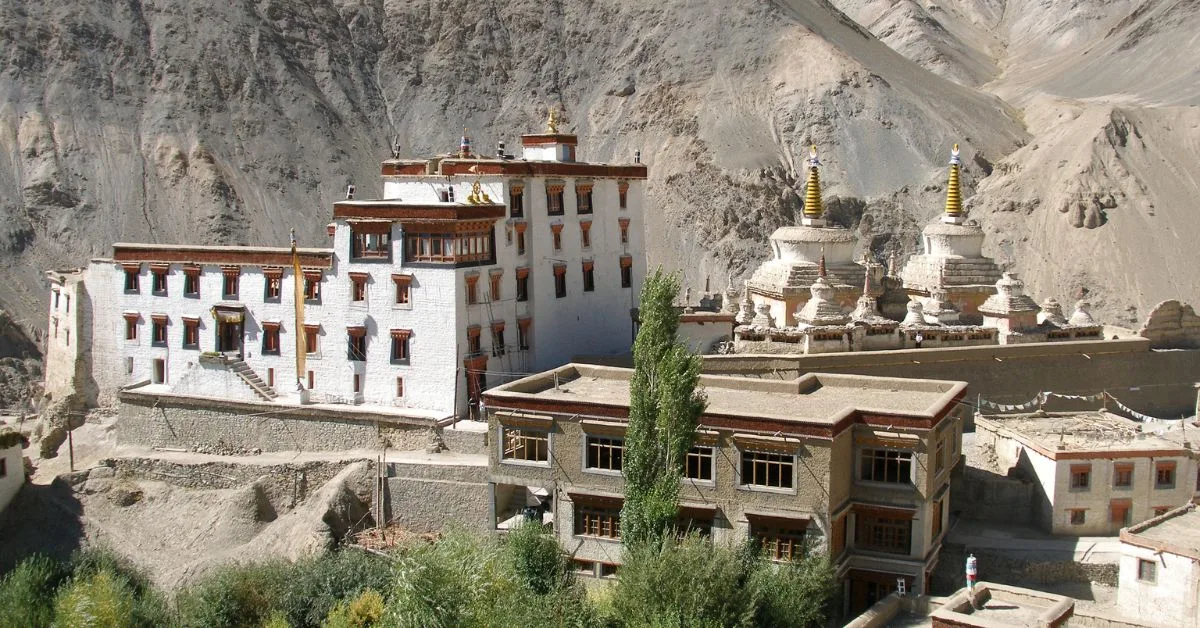Lamayuru Monastery is a special place perched high in the rocky mountains of Ladakh. People often call it the “Moonland” because the area looks like the moon. It’s really old and important to the people of Ladakh.
Built over a thousand years ago, it’s one of the oldest monasteries in the whole region. Standing on a hilltop, it looks magical and mysterious. The mix of the old monastery and the strange, beautiful landscape makes you feel like you’ve traveled back in time.
How to reach:
By Air:
The nearest airport to Lamayuru is Kushok Bakula Rimpochee Airport in Leh, which is approximately 125 kilometers away. Leh is well-connected by flights from major cities like Delhi, Mumbai, and Srinagar. From the airport, you can hire a taxi or rent a car to reach Lamayuru, which takes around 4-5 hours by road.
By Road:
Lamayuru is accessible via the Srinagar-Leh Highway (NH1), which offers a stunning road trip through the Himalayas. Here are the two main routes:
- From Leh (125 km): The drive from Leh to Lamayuru takes about 4-5 hours. The route passes through picturesque landscapes, including the Magnetic Hill and the confluence of the Indus and Zanskar rivers. Regular buses and shared taxis are available from Leh to Kargil, which pass through Lamayuru.
- From Srinagar (335 km): If you’re coming from Srinagar, the journey to Lamayuru via Kargil takes about 10-12 hours. This route is also popular among travelers for its scenic beauty, including views of Sonamarg and Drass, the second coldest inhabited place on earth.
By Bus:
State-run and private buses operate between Leh and Kargil, with stops at Lamayuru. These buses are a budget-friendly option but can be less comfortable than hiring a private vehicle. The journey offers breathtaking views of the Ladakh region’s stark beauty.
By Bike:
For adventure enthusiasts, reaching Lamayuru by motorcycle is a popular choice, especially for those undertaking the Srinagar-Leh or Manali-Leh circuit. The roads are well-maintained but require careful riding due to the challenging terrain and high altitude.
Best time to visit:
Spring (March to April)
- Weather: Spring marks the end of winter in Ladakh, with temperatures gradually rising. Daytime temperatures range from 5°C to 15°C, while nights are still cold.
- Experience: The landscape begins to thaw, with patches of greenery emerging amid the barren mountains. While the roads from Srinagar to Leh start to open up, occasional snow can still be encountered.
- Travel Tips: Ideal for travelers who enjoy cooler weather and want to avoid the summer crowds. However, be prepared for chilly nights and possible road delays.
Summer (May to September)
- Weather: This is the best time to visit, with temperatures ranging from 15°C to 25°C during the day and cooler nights. The weather is pleasant, and the skies are generally clear.
- Experience: The roads to Lamayuru are fully accessible, and the region comes alive with vibrant colors. The Yuru Kabgyat festival in June or July is a highlight, offering a deep dive into the local culture.
- Travel Tips: This period offers the most comfortable and convenient travel conditions. Ideal for sightseeing, photography, and attending local festivals.
Autumn (October to November)
- Weather: Autumn sees a drop in temperatures, with daytime highs between 10°C and 20°C and nights getting colder. The onset of winter begins in late October.
- Experience: The landscape takes on a golden hue, and the tourist crowds thin out. This is a good time for those who prefer solitude and want to experience Ladakh’s beauty without the summer rush.
- Travel Tips: Early autumn is still good for travel, but as November approaches, be prepared for colder temperatures and the possibility of snow.
Winter (December to February)
- Weather: Winter in Ladakh is harsh, with temperatures often dropping below freezing. Daytime highs can be around -5°C to 5°C, while nights can plunge to -20°C or lower.
- Experience: The monastery and surrounding areas are covered in snow, creating a tranquil, almost surreal atmosphere. However, the roads to Lamayuru are often closed due to heavy snowfall.
- Travel Tips: Only suitable for the most adventurous travelers equipped for extreme cold. Access to Lamayuru may be restricted, and local amenities are limited during this time.
Attractions:
Lamayuru Monastery:

Lamayuru Monastery, also called Yuru Monastery, is a very old and important place for Buddhist people in Ladakh. Built over a thousand years ago by a wise man named Naropa, it’s one of the oldest monasteries there. It sits high on a rocky hill, looking over a strange, moon-like landscape.
About 150 monks live there now, but it used to be home to many more. The monastery has lots of special rooms with beautiful old paintings, pictures, and statues that tell stories about the Buddhist way of life. The main room for praying is very special, with fancy wooden carvings, colorful pictures, and important religious things.
Yuru Kabgyat Festival:
The Yuru Kabgyat Festival is a big, fun party at Lamayuru Monastery. It happens every year in June or July and lasts for two days. People from all over come to see the colorful shows, music, and dancing.
The festival is about good winning over bad things. The monks do special things and wear cool masks that look like gods, scary monsters, and animals. They dance to loud drums and trumpets while telling stories about good and bad. People pray and give gifts to the gods to keep everyone safe and happy.

Moonland:

Right below Lamayuru Monastery is a place that looks like the moon! It’s called Moonland because the ground is smooth and wavy, with funny-shaped rocks. The land looks like this because the wind and water have been changing it for a very long time. The dirt is soft and comes in colors like yellow and orange, which look amazing against the blue sky.
It’s a perfect place to take pictures because everything is so strange and beautiful. Walking there feels like you’re on another planet, it’s so quiet and empty. The best time to go is when the sun is coming up or going down. The light makes the land look even more magical with long shadows. If you want to see a really special place in nature, you should definitely visit Moonland.
Local Experiences:
- Immerse yourself in local culture by attending the Yuru Kabgyat Festival, featuring vibrant mask dances and religious rituals.
- Explore the otherworldly landscape of Moonland, with its unique rock formations and lunar-like terrain.
- Find inner peace through meditation at Rizong Monastery, renowned for its tranquil atmosphere.
- Discover hidden gems at Wanla Monastery, an ancient site with beautiful statues and paintings.
- Appreciate artistic brilliance by visiting Alchi Monastery, famous for its intricate murals and frescoes.
- Unveil history through the ruins of Basgo Monastery, a grand old fortress with a rich past.
- Experience local life by staying in a traditional Ladakhi homestay in Uleytokpo.
- Connect with nature through camping by the Indus River, enjoying starry nights and stunning scenery.
- Witness a natural wonder at the confluence of the Indus and Zanskar rivers.
- Experience a mysterious phenomenon at Magnetic Hill, where gravity seems to defy logic.
Travel tips:
- Get used to the altitude: Spend a few days in Leh or another lower place before heading to Lamayuru to avoid getting sick from the height.
- Dress warmly: Pack layers of clothes, even in summer, as nights can be very cold.
- Stay hydrated: Drink lots of water, even if you don’t feel thirsty, because the air is dry.
- Be ready for limited phone service: Don’t rely on your phone to work well in Lamayuru.
- Hire a local guide: Learn about the area’s history and culture by hiring someone who lives there.
- Bring cash: There aren’t many places to use your card, so bring enough money.
- Respect the local customs: Dress modestly when visiting monasteries, take off your shoes, and be careful where you point your feet.
- Take it easy: Don’t do too much and avoid alcohol for the first few days to adjust to the altitude.
- Travel during daylight: The roads can be tricky, so it’s safer to drive when it’s light outside.
- Check festival dates: If you want to go to the Yuru Kabgyat Festival, find out when it is happening as the dates change every year.
Conclusion
Lamayuru Monastery transcends its role as a spiritual haven, transforming into a gateway to Ladakh’s vibrant culture and breathtaking landscapes. Xplro.com recommends a visit to Lamayuru, whether you’re captivated by the ancient rituals of the Yuru Kabgyat Festival, the otherworldly beauty of the Moonland, or the serene peace of nearby monasteries. This remote haven offers an unforgettable experience, a chance to step back in time and immerse yourself in the region’s Buddhist traditions, all while marveling at nature’s stark beauty. As you depart, you’ll carry more than just memories of breathtaking views and historic sites; you’ll possess a deeper understanding of Ladakh’s spiritual and cultural heritage. Lamayuru Monastery is a journey for the soul, where every moment spent brings you closer to peace and introspection. Visit Xplro.com to start planning your unforgettable Ladakh adventure.
FAQs
1. What makes Lamayuru Monastery unique?
- Lamayuru Monastery, also known as Yuru Monastery, is celebrated for its status as one of the oldest monasteries in Ladakh, with a history dating back to the 11th century. Its unique location on a hill provides breathtaking views of the surrounding landscape, including the distinctive Moonland area. The monastery’s architectural style and its collection of ancient thangkas and murals also contribute to its significance.
2. How can I travel to Lamayuru Monastery from Leh?
- Lamayuru Monastery is located about 127 kilometers from Leh. The most common way to reach it is by road, traveling along the Srinagar-Leh Highway. The journey typically takes 4-6 hours, and you can choose to hire a taxi or take a local bus service.
3. When is the ideal time to visit Lamayuru Monastery?
- The best time to visit Lamayuru Monastery is from May to September. During this period, the weather is generally pleasant, the roads are open, and you can experience local festivals such as the Yuru Kabgyat Festival, which usually takes place in June or July.
4. What should I wear when visiting the Lamayuru Monastery?
- Visitors should dress modestly when entering the monastery. It is recommended to wear clothing that covers the shoulders and knees. Removing your shoes before entering prayer halls is also customary.
5. Are there places to stay near Lamayuru Monastery?
- Yes, there are various accommodation options in and around Lamayuru. You can find guesthouses and hotels catering to different budgets. Additionally, some local homestays offer a chance to experience traditional Ladakhi hospitality.
6. Is it advisable to hire a local guide for the visit?
- Hiring a local guide is not mandatory but can greatly enhance your visit. A guide can offer detailed information about the monastery’s history, its cultural significance, and local customs, making your experience more informative.
7. What types of food are available near the Lamayuru Monastery?
- In Lamayuru, you can enjoy traditional Ladakhi dishes such as momos (dumplings), thukpa (noodle soup), and tsampa (barley flour porridge). There are also small restaurants and eateries providing basic vegetarian and non-vegetarian options.
8. How much time should I allocate for visiting Lamayuru Monastery?
- A typical visit to Lamayuru Monastery takes about 2-3 hours. This time allows for exploring the monastery, viewing the art and statues, and taking in the scenic views. If you plan to attend the Yuru Kabgyat Festival or explore nearby sites, you might want to spend additional time.
9. Can I take photographs inside the Lamayuru Monastery?
- Photography inside the monastery is generally restricted, especially in sacred areas like prayer halls. It’s important to follow the monastery’s guidelines regarding photography and to respect any restrictions.
10. Is public transport available to Lamayuru Monastery?
- Yes, public buses run between Leh and Lamayuru, although they may not be as frequent or convenient as private transportation. Checking bus schedules ahead of time is advisable. Hiring a taxi might offer more flexibility and comfort for your journey.
11. Are there any fees for entering the monastery?
- There is typically a small entry fee for visiting Lamayuru Monastery. Fees can vary, so it’s a good idea to bring cash and check local information for the most current rates.
12. What health precautions should I take before visiting?
- To mitigate the effects of high altitude, it’s important to acclimatize in Leh before heading to Lamayuru. Drink plenty of water, avoid strenuous activities initially, and consult a healthcare provider if you have any health concerns. Consider carrying altitude sickness medication if necessary.




